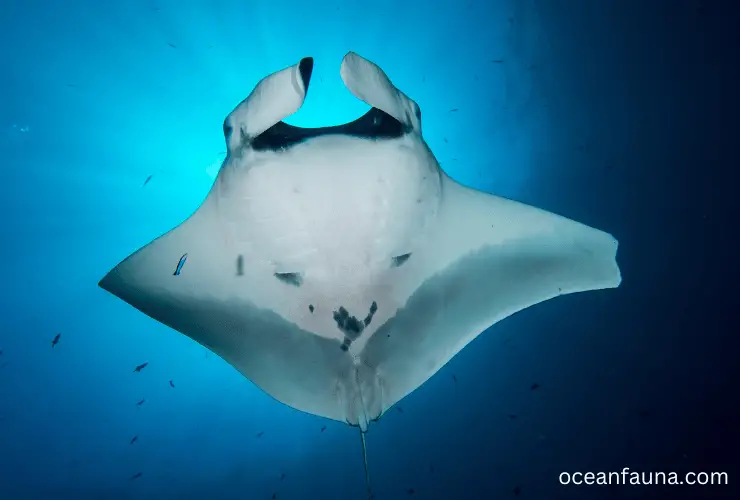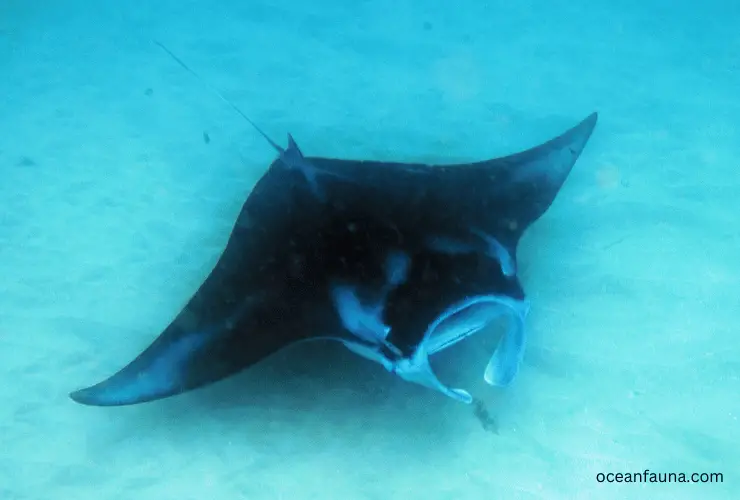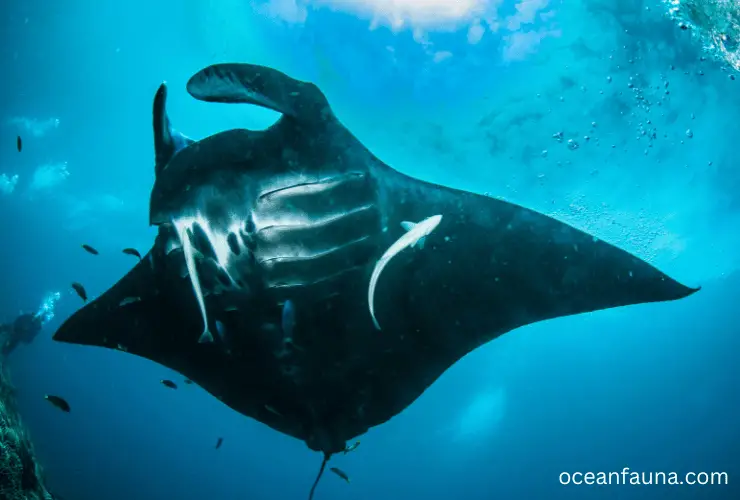Manta rays are not mammals. They are fish. Manta rays belong to the cartilaginous fish family and other species, such as sharks and rays. If we go into more detail, Manta Rays are viviparous. This means they produce live young, hatched inside the mother.
They are characterized by their flat, broad bodies and large, triangular pectoral fins. Manta rays do not have a skeleton made of bone-like many other fish. Instead, they have a skeleton made of cartilage.
They also have gills that allow them to breathe underwater and give birth to live young rather than laying eggs like many other fish species.
What is Considered a Mammal?
Mammals are a class of vertebrate animals characterized by certain defining features. These include the possession of hair or fur, the capability to produce milk to feed their young, and the presence of three middle ear bones.
Mammals are warm-blooded and have a highly developed nervous system, which allows them to exhibit advanced behaviors and adaptations.
They also have unique reproductive systems, with females typically giving birth to live young rather than laying eggs. There are over 5,500 species of mammals, ranging in size from the tiny bumblebee bat to the massive blue whale.
Some well-known mammals include humans, dogs, cats, cows, whales, monkeys, and bears.
Fish vs. Mammal
Mammals and fish are two distinct classes of animals that belong to separate branches of the animal kingdom. One of the distinguishing features between mammals and fish is their physical structure. Fish have fins, scales, and gills, which allow them to swim and breathe underwater.

In contrast, mammals have hair or fur, mammary glands for nursing their young, and lungs for breathing air. Fish lay eggs, while mammals give birth to live young.
Another difference between mammals and fish is their behavior and adaptations. Mammals exhibit advanced behaviors, such as nurturing their young and exhibiting complex social structures.
At the same time, fish have evolved unique adaptations, such as producing bioluminescence or moving quickly through the water.
While both mammals and fish are essential components of the animal kingdom, they have evolved distinct adaptations and behaviors to survive and thrive in their respective environments.
What Type of Animal Is A Manta Ray: Fish Or Mammal?
Manta rays are large, flat, and large marine animals that belong to the family Mobulidae. They are considered cold-blooded of the cartilaginous type, meaning their skeletons are made of cartilage instead of bone.
Manta rays are part of the same class of animals as sharks and skates, Chondrichthyes. They are not mammals, as mammals are characterized by their warm-bloodedness, mammary glands, hair, and three middle ear bones.
Why are Manta Rays Not Mammals?
Manta Rays are not considered mammals because they belong to the class Chondrichthyes, which includes all cartilaginous fish, like sharks, skates, and rays. Manta rays are distinguishable by their large, flat bodies, which they use to filter feed on small organisms.
Unlike mammals, they do not have a bony skeleton and instead have a skeleton made of cartilage. They also lack mammary glands and are not warm-blooded, relying on gills to breathe and regulate their body temperature.
Why do Whales are Mammal, But Manta Rays are Fish?
A whale is considered a mammal because it meets the key characteristics of a mammal, such as having hair or fur, mammary glands to nurse their young, and the ability to regulate its body temperature.

Here are some of the characteristics in details of why whales are mammals:
- Warm-blooded: Whales are warm-blooded, which means they can regulate their body temperature, allowing them to survive in cold ocean environments.
- Hair or fur: Although whales do not have much hair or fur, they have a few sparse hairs around their mouth and chin that are thought to have a sensory function.
- Mammary glands: Whales have mammary glands that produce milk to feed their young.
- Lungs: Whales breathe air through their lungs, like other mammals, and need to reach the surface to take a breath.
- Central Nervous System: Whales have a complex central nervous system that allows them to display complex behaviors and communication.
- Live birth: Whales give birth to live young rather than laying eggs
Manta rays are considered fish because they have gills to extract oxygen from water, have a streamlined body structure adapted for swimming, and have fins and a tail to help them move through the water.
Manta rays belong to the scientific class Chondrichthyes, which includes other types of fish such as sharks, skates, and rays.
Here are some of the characteristics in detail of why Manta Rays are fish:
- Gills: Manta rays have gills that they use to extract oxygen from the water, allowing them to breathe underwater.
- Streamlined body: Manta rays have a flat, disc-like body that is streamlined for swimming, reducing resistance in the water.
- Fins and tail: Manta rays have large pectoral fins and a large, triangular-shaped tail (caudal fin) for propulsion and maneuvering in the water.
- Scales: Manta rays have small, tooth-like structures called denticles that provide a rough texture and serve as protective armor.
- Cold-blooded: Manta rays are cold-blooded, meaning their body temperature is determined by the temperature of their environment.
- Lay eggs: Some species of rays, including manta rays, lay eggs, while others give birth to live young.
Is manta ray carnivore, omnivore, or herbivore: What does it eat?
Manta rays are carnivores. They feed mainly on small fish and plankton, including krill, copepods, and small squid. They are filter feeders, meaning they swim with their mouths open, filtering large amounts of water through their gill rakers to capture food.

Manta rays have a unique feeding adaptation in that they are able to manipulate the water flow with their cephalic fins, which are located on the front of their head, to guide food toward their mouth.
They also have large, circular mouths that can open wide to allow for large amounts of food and water intake.
So to sum it all up, manta rays are carnivores that feed mainly on small fish and plankton. They are specialized filter feeders with adaptations to capture their food from the water efficiently.
FAQs
What is a manta ray baby called?
A baby manta ray is called a “PUP.”
Are Manta Rays Blind?
No, manta rays are not blind. They have well-developed eyes that allow them to see their environment and navigate in the water. Manta rays have large, forward-facing eyes that are set on the sides of their head, giving them a wide field of vision.
They use their eyes to detect movement and identify potential prey, as well as to avoid predators and navigate their environment. Additionally, manta rays have excellent low-light vision, which is an adaptation to their deep-water habitat where light is limited.
They also have a well-developed sense of smell, which they use to locate food and mates.
Is a Manta Ray a Devil Fish?
No, manta rays are not considered devil fish. The term “devil fish” is sometimes used to refer to the manta ray. Still, it is not a scientifically recognized term, and the manta ray is not considered a devil fish in a biological or taxonomic sense.
How Big is The Largest Manta Ray?
According to the source, the largest Manta Ray was found on 23rd August 1933. It weighed almost over 5,000 pounds and was over 20 feet wide.
Are Fish a Mammal?
No, fish are not and cannot be mammals. Fish and mammals are different classes of animals that belong to different taxonomic groups.
Fish belong to the phylum Chordata and class Osteichthyes, while mammals belong to the phylum Chordata and class Mammalia.
Gills and fins characterize fish, and a streamlined body is adapted for swimming. In contrast, mammals are characterized by hair or fur, mammary glands, and the ability to regulate body temperature internally.
Where manta rays can be found?
Manta rays can be found in tropical and subtropical waters around the world, but some of the best places to see manta rays in large numbers include:
- The Maldives: The clear waters of the Maldives are home to large populations of manta rays, particularly in the Hanifaru Bay Marine Protected Area.
- Hawaii: The waters around the Hawaiian islands are known for their high concentrations of manta rays, especially on the Kona Coast of the Big Island.
- Mexico: The waters of Mexico, particularly in the Sea of Cortez, are home to large populations of manta rays and other marine life.
- Australia: The Great Barrier Reef in Australia is home to many species of manta rays and is a well-liked destination for diving and snorkeling.
- Mozambique: The waters around the African country of Mozambique are known for their diverse marine life, including manta rays, whale sharks, and other species of rays and sharks.
Conclusion
So, now, it’s clear that there are huge differences between manta ray and mammals. Both the creatures have their own habitual behavior. So don’t be confused.


2 thoughts on “Is Manta Ray A Fish or A Mammal? [Explained]”